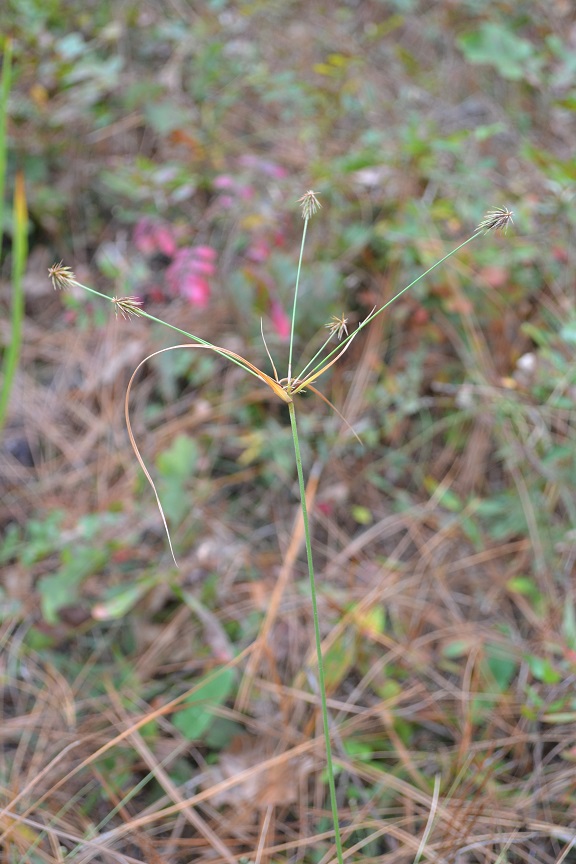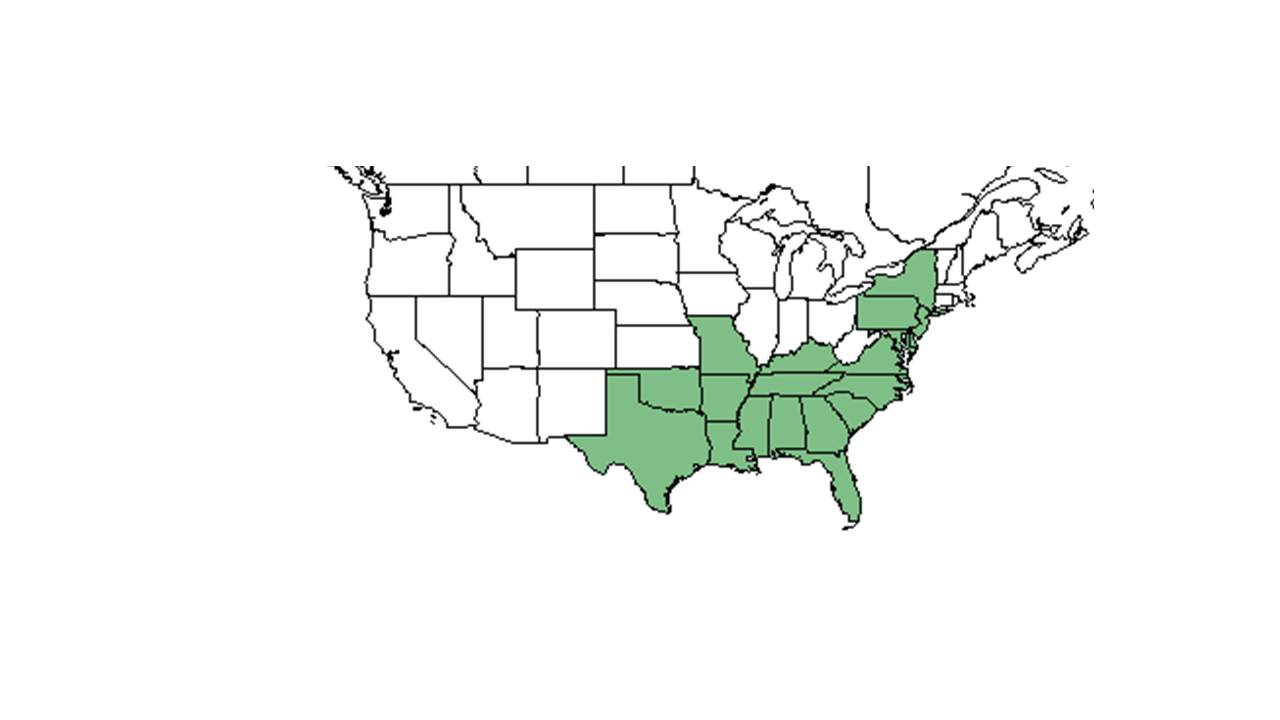Cyperus plukenetii
| Cyperus plukenetii | |
|---|---|

| |
| Photo taken by Kevin Robertson | |
| Scientific classification | |
| Kingdom: | Plantae |
| Division: | Magnoliophyta - Flowering plants |
| Class: | Liliopsida – Monocotyledons |
| Order: | Poales |
| Family: | Cyperaceae |
| Genus: | Cyperus |
| Species: | C. plukenetii |
| Binomial name | |
| Cyperus plukenetii Fernald | |

| |
| Natural range of Cyperus plukenetii from USDA NRCS Plants Database. | |
Common names: Plukenet's flatsedge; starburst flatsedge
Contents
Taxonomic notes
Synonyms: none[1]
Varieties: none[1]
Description
A description of Cyperus plukenetii is provided in The Flora of North America. Cyperus plukenetii is a perennial graminoid. Individual plants have numerous stems, each with a cormose base; and the bases are tightly bunched together. [2]
Distribution
Cyperus plukenetii is native from New Jersey, Kentucky, Missouri, and southeast Oklahoma south to central peninsular Florida and west to eastern Texas.[3]Its distribution in Florida is restricted to the northern portion of the state.[4]
Ecology
Habitat
C. plukenetii requires sandy soils.[5] It also prefers higher light levels, from open to semi-open conditions. [2] It is found in sparse scrub woods, woods' edges, and open fields.[6] Other habitat types include dry pine and oak lands, scrub oak sandhills, turkey oak-longleaf pine barrens, open hardwood stands, open upland pine forests, and river banks, but it is infrequent in open stands of longleaf pine and wiregrass. [2] It also has been found in disturbed areas, including bulldozed scrub oak sandhills, cut-over longleaf pine-turkey oak sand ridges and flatwoods, pasture fence lines, young pine plantations, and roadsides. [2] C. plukenetii has shown regrowth in reestablished longleaf pine woodlands that were disturbed by agricultural practices in South Carolina, making it a post-agricultural woodland indicator species.[7]
Associated species include Liatris, Agalinis, Chrysopsis, Aristida stricta, Phoebanthus tenuifolias, Eupatorium album, Pteridium aquilinum var. pseudacaidatum, Serenoa repens, Quercus margaretta, Q. minima, Q. ellottii. [2]
Cyperus plukenetii is an indicator species for the North Florida Longleaf Woodlands community type as described in Carr et al. (2010).[8]
Phenology
It is known to flower from July to October.[3]
Seed dispersal
It can be dispersed in a variety of ways: rain wash, transport of achenes in mud on feet of migratory waterfowl,[9] ingestion of fruits by migratory waterfowl,[10] and flotation of achenes (Chermezon 1924; Ridley 1930; Lye 1981)[11]It also uses animals as dispersal agents by attaching to their fur by spikelets.[5] This species is thought to be dispersed by gravity. [12]
Seed bank and germination
Seeds of C. plukenetii may not persist in the seed bank for long, since a study only found seeds in 1 year samples from sandhill sites where it is found in differing fire histories.[13]
Fire ecology
Populations of Cyperus plukenetii have been known to persist through repeated annual burns,[14][15] showing this species is fire tolerant.[2]
Conservation, cultivation, and restoration
C. plukenetii is listed as historical by the Kentucky State Nature Preserves Commission, as endangered and extirpated by the Maryland Department of Natural Resources, as endangered by the New Jersey Department of Environmental Protection, and as a species of special concern by the Tennessee Department of Environment and Conservation.[16]
Cultural use
Photo Gallery
References and notes
- ↑ 1.0 1.1 Weakley, A.S. 2020. Flora of the Southeastern United States. Edition of 20 October 2020. University of North Carolina at Chapel Hill, Chapel Hill, North Carolina.
- ↑ 2.0 2.1 2.2 2.3 2.4 2.5 Florida State University Robert K. Godfrey Herbarium database. URL: http://herbarium.bio.fsu.edu. Last accessed: June 2014. Collectors: A. H. Curtiss, R. Kral, R.K. Godfrey, Gary R. Knight, George R. Cooley, Richard J. Eaton, R. F. Doren, R L Lazor, V. Sullivan, Holly Maurushat, Richard S. Mitchell, Loran C. Anderson, Andre F. Clewell, and Kevin Oakes. States and Counties: Florida: Calhoun, Duval, Hernando, Jackson, Jefferson, Leon, Liberty, Marion, Okaloosa, Taylor, Wakulla, and Walton. Georgia: Baker, Grady, and Marion.
- ↑ 3.0 3.1 Weakley, A. S. (2015). Flora of the Southern and Mid-Atlantic States. Chapel Hill, NC, University of North Carolina Herbarium.
- ↑ Carr, S. C., et al. (2010). "A Vegetation Classification of Fire-Dependent Pinelands of Florida." Castanea 75(2): 153-189.
- ↑ 5.0 5.1 Carter, R. (1993). "Animal dispersal of the North American Sedge, Cyperus plukenetii (Cyperaceae)." American Midland Naturalist 129: 352-356.
- ↑ CARTER, R. 1984. A systematic study of the New World species of section Umbellati of Cyperus. Unpubl. Ph.D. Thesis, Vanderbilt University, Nashville, Tenn. 279 p. Carter, R. (1993). "Animal dispersal of the North American Sedge, Cyperus plukenetii (Cyperaceae)." American Midland Naturalist 129: 352-356.
- ↑ Brudvig, L.A., E Grman, C.W. Habeck, and J.A. Ledvina. (2013). Strong legacy of agricultural land use on soils and understory plant communities in longleaf pine woodlands. Forest Ecology and Management 310: 944-955.
- ↑ Carr, S.C., K.M. Robertson, and R.K. Peet. 2010. A vegetation classification of fire-dependent pinelands of Florida. Castanea 75:153-189.
- ↑ RIDLEY, H. N. 1930. The dispersal of plants throughout the world. L. Reeve & Co., Ltd., Ashford, Kent. 744 p. Carter, R. (1993). "Animal dispersal of the North American Sedge, Cyperus plukenetii (Cyperaceae)." American Midland Naturalist 129: 352-356.
- ↑ RIDLEY, H. N. 1930. The dispersal of plants throughout the world. L. Reeve & Co., Ltd., Ashford, Kent. 744 p. BEND, G. 1937. Eigenartige verbreitung-seinrichtungen bei der Cyperaceen gattung Gahnia. Flora, 131:369-386. Carter, R. (1993). "Animal dispersal of the North American Sedge, Cyperus plukenetii (Cyperaceae)." American Midland Naturalist 129: 352-356.
- ↑ CHERMEZON, H. 1924. Sur la dissemination de quelques Cyperacees. Bull. Soc. Bot. France, 71:849- 861. RIDLEY, H. N. 1930. The dispersal of plants throughout the world. L. Reeve & Co., Ltd., Ashford, Kent. 744 p. LYE, K. A. 1981. Studies in African Cyperaceae 19. The genera of Anosporum Nees and Sorostachys Steudel. Nord. J. Bot., 1:186-191.
- ↑ Kirkman, L. Katherine. Unpublished database of seed dispersal mode of plants found in Coastal Plain longleaf pine-grasslands of the Jones Ecological Research Center, Georgia.
- ↑ Parks, G. R. (2007). Longleaf pine sandhill seed banks and seedling emergence in relation to time since fire, University of Florida. Master of Science: 84.
- ↑ Robertson, K.M. Unpublished data collected from Pebble Hill Fire Plots, Pebble Hill Plantation, Thomasville, Georgia.
- ↑ Glitzenstein, J. S., D. R. Streng, R. E. Masters, K. M. Robertson and S. M. Hermann 2012. Fire-frequency effects on vegetation in north Florida pinelands: Another look at the long-term Stoddard Fire Research Plots at Tall Timbers Research Station. Forest Ecology and Management 264: 197-209.
- ↑ USDA, NRCS. (2016). The PLANTS Database (http://plants.usda.gov, 25 April 2019). National Plant Data Team, Greensboro, NC 27401-4901 USA.